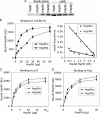GCUNC45 is the first Hsp90 co-chaperone to show alpha/beta isoform specificity
- PMID: 18285346
- PMCID: PMC2442279
- DOI: 10.1074/jbc.C800017200
GCUNC45 is the first Hsp90 co-chaperone to show alpha/beta isoform specificity
Abstract
Hsp90 is an essential molecular chaperone required for the normal functioning of many key regulatory proteins in eukaryotic cells. Vertebrates have two closely related isoforms of cytosolic Hsp90 (Hsp90alpha and Hsp90beta). However, specific functions for each isoform are largely unknown, and no Hsp90 co-chaperone has been reported to distinguish between the two isoforms. In this study, we show that the Hsp90 co-chaperone GCUNC45 bound preferentially to the beta isoform of Hsp90 in vitro. GCUNC45 efficiently blocked the progression of progesterone receptor chaperoning in an in vitro functional system when Hsp90beta was used, but did so with much less efficacy when Hsp90alpha was used. Knockdown experiments in HeLa cells showed that GCUNC45 is required for the normal cellular distribution of Hsp90beta, but not Hsp90alpha. This is the first example of a co-chaperone with isoform selectivity, and this approach may open novel avenues to understanding the functional differences between Hsp90 isoforms.
Figures




Similar articles
-
Expressed as the sole Hsp90 of yeast, the alpha and beta isoforms of human Hsp90 differ with regard to their capacities for activation of certain client proteins, whereas only Hsp90beta generates sensitivity to the Hsp90 inhibitor radicicol.FEBS J. 2007 Sep;274(17):4453-63. doi: 10.1111/j.1742-4658.2007.05974.x. Epub 2007 Aug 6. FEBS J. 2007. PMID: 17681020
-
Client Proteins and Small Molecule Inhibitors Display Distinct Binding Preferences for Constitutive and Stress-Induced HSP90 Isoforms and Their Conformationally Restricted Mutants.PLoS One. 2015 Oct 30;10(10):e0141786. doi: 10.1371/journal.pone.0141786. eCollection 2015. PLoS One. 2015. PMID: 26517842 Free PMC article.
-
Middle domain of human Hsp90 isoforms differentially binds Aha1 in human cells and alters Hsp90 activity in yeast.Biochim Biophys Acta. 2015 Feb;1853(2):445-52. doi: 10.1016/j.bbamcr.2014.11.026. Epub 2014 Dec 5. Biochim Biophys Acta. 2015. PMID: 25486457
-
Cytosolic Hsp90 Isoform-Specific Functions and Clinical Significance.Biomolecules. 2022 Aug 23;12(9):1166. doi: 10.3390/biom12091166. Biomolecules. 2022. PMID: 36139005 Free PMC article. Review.
-
The Distinct Assignments for Hsp90α and Hsp90β: More Than Skin Deep.Cells. 2023 Jan 11;12(2):277. doi: 10.3390/cells12020277. Cells. 2023. PMID: 36672211 Free PMC article. Review.
Cited by
-
Novel Hsp90 partners discovered using complementary proteomic approaches.Cell Stress Chaperones. 2009 Nov;14(6):629-38. doi: 10.1007/s12192-009-0115-z. Epub 2009 Apr 26. Cell Stress Chaperones. 2009. PMID: 19396626 Free PMC article.
-
UCS protein function is partially restored in the Saccharomyces cerevisiae she4 mutant with expression of the human UNC45-GC, but not UNC45-SM.Cell Stress Chaperones. 2018 Jul;23(4):609-615. doi: 10.1007/s12192-017-0870-1. Epub 2017 Dec 29. Cell Stress Chaperones. 2018. PMID: 29288355 Free PMC article.
-
Lack of developmental redundancy between Unc45 proteins in zebrafish muscle development.PLoS One. 2012;7(11):e48861. doi: 10.1371/journal.pone.0048861. Epub 2012 Nov 7. PLoS One. 2012. PMID: 23144999 Free PMC article.
-
Mutations in Hsp90 Cochaperones Result in a Wide Variety of Human Disorders.Front Mol Biosci. 2021 Dec 8;8:787260. doi: 10.3389/fmolb.2021.787260. eCollection 2021. Front Mol Biosci. 2021. PMID: 34957217 Free PMC article. Review.
-
Mutation of the Ser18 phosphorylation site on the sole Saccharomyces cerevisiae UCS protein, She4, can compromise high-temperature survival.Cell Stress Chaperones. 2017 Jan;22(1):135-141. doi: 10.1007/s12192-016-0750-0. Epub 2016 Nov 25. Cell Stress Chaperones. 2017. PMID: 27888470 Free PMC article.
References
-
- Pratt, W. B., and Toft, D. O. (2003) Exp. Biol. Med. 228 111–133 - PubMed
-
- Wegele, H., Muller, L., and Buchner, J. (2004) Rev. Physiol. Biochem. Pharmacol. 151 1–44 - PubMed
-
- Csermely, P., Schnaider, T., Soti, C., Prohaszka, Z., and Nardai, G. (1998) Pharmacol. Ther. 79 129–168 - PubMed
-
- Stebbins, C. E., Russo, A. A., Schneider, C., Rosen, N., Hartl, F. U., and Pavletich, N. P. (1997) Cell 89 239–250 - PubMed
-
- Wright, L., Barril, X., Dymock, B., Sheridan, L., Surgenor, A., Beswick, M., Drysdale, M., Collier, A., Massey, A., Davies, N., Fink, A., Fromont, C., Aherne, W., Boxall, K., Sharp, S., Workman, P., and Hubbard, R. E. (2004) Chem. Biol. 11 775–785 - PubMed
Publication types
MeSH terms
Substances
Grants and funding
LinkOut - more resources
Full Text Sources
Molecular Biology Databases
Research Materials
Miscellaneous

